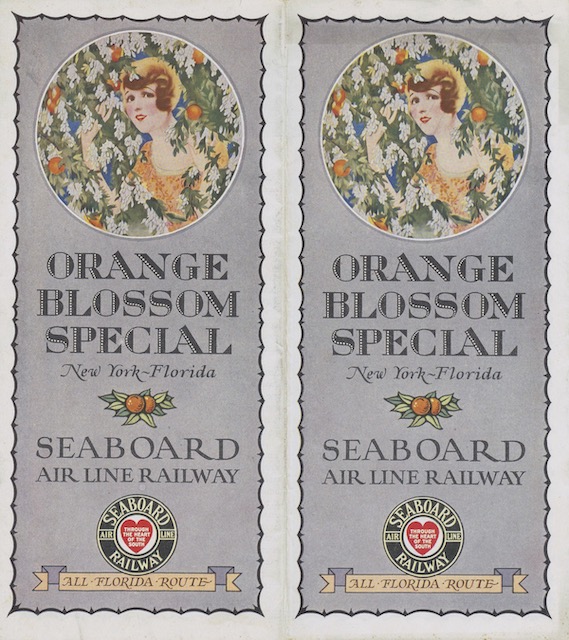In 1924, Seaboard extended its Florida line to West Palm Beach, then reached Miami in 1926. Both the ACL and Southern Railway had to share revenues from Miami-bound passengers with the Florida East Coast, but Seaboard now had its own route.
 Click image to download a 4.7-MB PDF of this 8-page booklet from the Touchton Map Library.
Click image to download a 4.7-MB PDF of this 8-page booklet from the Touchton Map Library.
To celebrate the opening of the route to West Palm Beach, on November 21, 1925, Seaboard introduced a new year-round all-Pullman train, the Orange Blossom Special. This booklet, which was issued on February 1, 1926, “seventy days after this train was put in operation,” includes schedules to St. Petersburg on the West Coast and to West Palm Beach on the East Coast. It also includes schedules of the winter-only, all-Pullman Seaboard Florida Limited.
According to the equipment listing, the Orange Blossom Special included a club car, diner, observation car, and three sleeping cars between New York and West Palm Beach, a fourth sleeper between Washington and West Palm Beach, two sleepers between New York and St. Petersburg, and a sleeper between Washington and St. Petersburg. Between Washington and Wildwood (where the two lines split), then, it included ten cars plus whatever baggage cars were carried.
The Seaboard Florida Limited was actually two trains, one going to St. Petersburg and one to West Palm. The East Coast train consisted of a club car, diner, observation car, and two sleeping cars between New York and West Palm Beach plus a sleeper from Washington to West Palm Beach. A sleeper to West Palm Beach was added at Jacksonville to accommodate travelers from the Midwest and a once-a-week sleeper went to Detroit over Southern’s Suwanee River Special.
The West Coast train left New York an hour and fifteen minutes after the train to West Palm Beach. Like the East Coast section, it had club, diner, and observation cars but sleepers included two between New York and St. Petersburg, one New York-Tampa, one New York-Sarasota, one New York-Boca Grande, one Washington-St. Petersburg, a twice-a-week sleeper to Detroit, and a three-times-a-week sleeper to Quebec. In addition, it had one sleeper from New York to West Palm Beach which went on a separate train from Jacksonville to West Palm in order “to serve Central Florida resorts at a reasonable hour” since the East Coast section arrived at resorts in places like Winter Haven and Sebring too early in the morning for the wealthy travelers who rode these trains. That’s as many as 11 cars plus baggage cars.
Judging from these timetables, train speeds hadn’t increased much since 1904. In that year, the Seaboard Florida Limited was scheduled to go from New York to Jacksonville in 25 hours and 25 minutes, and Atlantic Coast Line’s Florida Special did the same trip in 25 hours and 40 minutes. In 1926, Seaboard’s main trains no longer went to Jacksonville, but New York to Baldwin, Florida, which was about the same distance, took 25 hours and 40 minutes on the Orange Blossom Special. ACL’s Florida Mail train took 23 hours and 20 minutes in 1926.

A Florida Motor Lines bus in 1921. The “parlor car bus” that operated between West Palm Beach and Miami in 1926 may have been a little posher than this one.
When this booklet was published, Seaboard hadn’t quite completed its line to Miami. In the meantime, the booklet notes, passengers could take a “parlor car bus” that featured “individual Pullman seats” from West Palm Beach. These were operated by Florida Motor Lines, which eventually became part of Greyhound.
